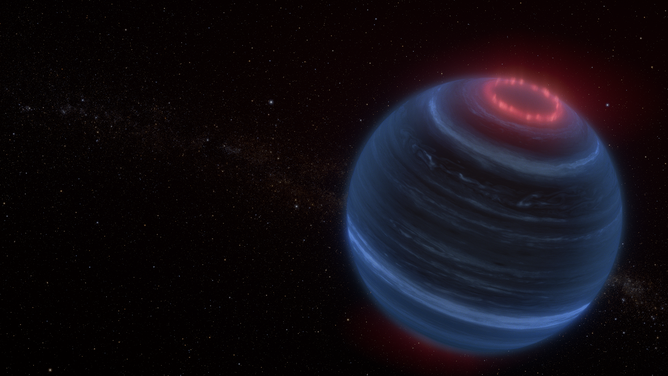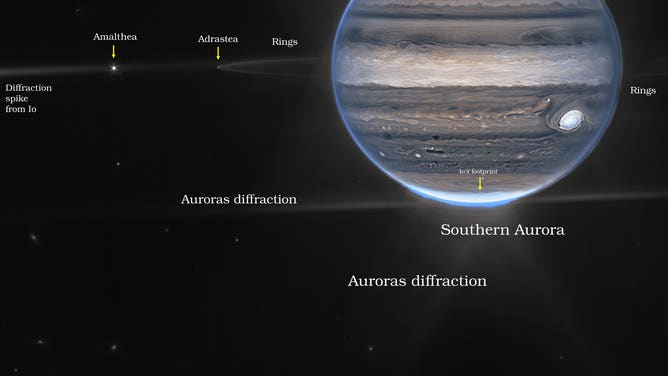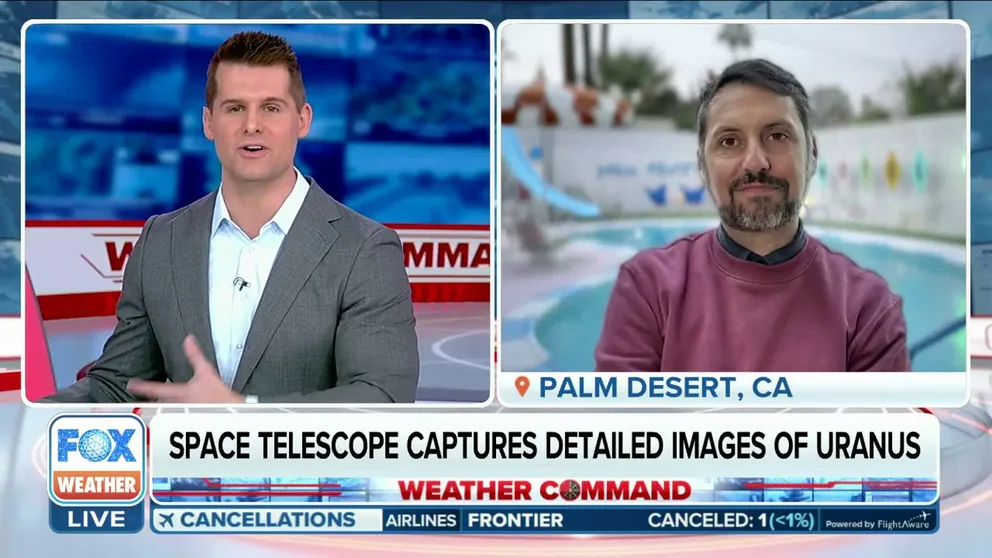NASA's Webb telescope finds glowing surprise on brown dwarf
Astronomers expected to see methane on brown dwarf W1935 but they didn't expect it to be glowing. NASA said W1935 is the first auroral candidate outside our solar system with a signature of methane and the coldest.
Celebrating another year of James Webb Space Telescope's stunning images
Kevin Hainline, one of the scientists working with the James Webb Space Telescope, says that every time they receive a photo dump from the telescope, they get to see a part of space in a new light. They are still getting over the image of Jupiter, but now they have a picture of Uranus, released just 11 days ago. They are excited to learn more about this image and what it reveals about our universe.
Astronomers using NASA’s James Webb Space Telescope to study brown dwarfs were surprised to find glowing methane resembling aurora lights on a cold brown dwarf.
American Museum of Natural History Astronomer Jackie Faherty used the Webb telescope to observe 12 cold brown dwarfs, including W1935 and W2220. According to the study presented at the 243rd meeting of the American Astronomical Society, these worlds appeared to be "near clones of each other," with one exception. Webb found methane emissions from W1935 in infrared wavelength.

This artist concept portrays the brown dwarf W1935, which is located 47 light-years from Earth. Astronomers using NASA’s James Webb Space Telescope found infrared emission from methane coming from W1935. (Image: NASA, ESA, CSA, Leah Hustak (STScI)
(NASA)
However, this methane was glowing instead of being absorbed. This was a surprise to astronomers.
"We expected to see methane because methane is all over these brown dwarfs. But instead of absorbing light, we saw just the opposite: The methane was glowing. My first thought was, ‘What the heck? Why is methane emission coming out of this object?’" Faherty said.
Brown dwarfs are a different classification of celestial body. According to NASA, sometimes known as "failed stars," brown dwarfs are not planets or stars. These worlds are larger than Jupiter, not as big as a star and form like stars, but they do not radiate starlight or have a host star.
Astronomers in the study used modeling to find a temperature inversion, with the atmosphere getting warmer at higher altitudes.
WEBB TELESCOPE SPOTS NEW WEATHER FEATURE ON JUPITER MOVING TWICE AS FAST AS CATEGORY 5 HURRICANE
Study co-author Ben Burningham of the University of Hertfordshire said this was "really puzzling" because brown dwarfs do not have a star, and there is no apparent heat source of upper atmosphere energy that could cause aurorae.
The graphic from NASA below shows the methane emission from W1935 compared to atmospheric methane seen on W2220.

Wavelengths of light from brown dwarfs, W1935 and W2220 as seen by the James Webb Space Telescope. W1935 showed emission from methane, as opposed to the anticipated absorption feature that was observed toward W2220. (Image: NASA, ESA, CSA, Leah Hustak (STScI))
(NASA)
"We have seen this kind of phenomenon in planets with a nearby star that can heat the stratosphere, but seeing it in an object with no obvious external heat source is wild," Burningham said.
7 THINGS TO KNOW ABOUT THE NORTHERN LIGHTS
On Earth, aurora borealis, or the Northern Lights, are created when particles from the Sun crash into Earth’s magnetic field, working down through the atmosphere and colliding with different molecules to create the dancing lights.

Webb NIRCam composite image from two filters – F212N (orange) and F335M (cyan) – of Jupiter system, unlabeled (top) and labeled (bottom). (Credit: NASA, ESA, CSA, Jupiter ERS Team; image processing by Ricardo Hueso (UPV/EHU) and Judy Schmidt.)
Other planets within our solar system have aurora lights, like Jupiter and Saturn. Jupiter’s auroras at both poles are created through a similar process on a much larger scale than Earth's. However, both Jupiter and Saturn have moons that contribute to auroral processes in addition to solar wind.
JAMES WEBB SPACE TELESCOPE CAPTURES JUPITER'S SWIRLING WEATHER, COLORFUL AURORAS AND RINGS
The isolated brown dwarf W1935 does not influence stellar wind to help fuel the aurora process.
Astronomers with the study believe that, like Jupiter and Saturn, the brown dwarf has internal processes or external interactions from active moons that may account for the emissions.
According to NASA, W1935 is not the first time an aurora has been suspected on a brown dwarf, but it is the first auroral candidate outside our solar system with a signature of methane and the coldest.
